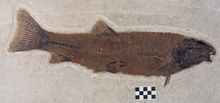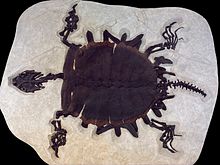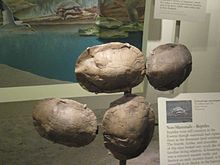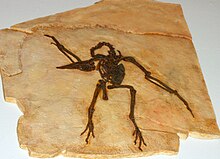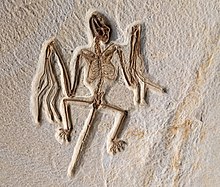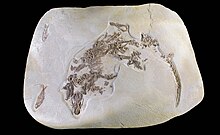From Wikipedia, the free encyclopedia
The Green River Formation is a famous Konservat-Lagerstätte located in the Intermountain West of the United States, in the states of Colorado, Utah, and Wyoming. It comprises sediments deposited during the Early Eocene in a series of large freshwater lakes: Lake Gosiute, Lake Uinta, and Fossil Lake (the last containing Fossil Butte National Monument). It preserves a high diversity of freshwater fish, birds, reptiles, and mammals.
| Genus
|
Species
|
Member
|
Abundance
|
Notes
|
Image
|
| Asterotrygon
|
A. maloneyi
|
Fossil Lake
|
|
A stingray of uncertain affinities.[1]
|

|
| Heliobatis
|
H. radians
|
|
A stingray of uncertain affinities.
|

|
Primarily based on Grande (2001), with changes where necessary:[2]
| Genus
|
Species
|
Member
|
Abundance
|
Notes
|
Image
|
| Eohiodon
|
E. falcatus
|
Fossil Lake
|
|
A hiodontid.
|

|
| Genus
|
Species
|
Member
|
Abundance
|
Notes
|
Image
|
| Phareodus
|
P. encaustus
|
Fossil Lake, Lake Gosiute
|
|
A bonytongue.
|

|
| P. testis
|
Fossil Lake
|
|

|
| Genus
|
Species
|
Member
|
Abundance
|
Notes
|
Image
|
| Gosiutichthys
|
G. parvus
|
Lake Gosiute
|
|
A clupeiform.
|
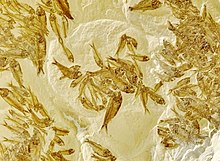
|
| Knightia
|
K. alta
|
Fossil Lake, Lake Gosiute & Lake Uinta
|
|
A clupeiform. The most commonly found articulated vertebrate fossil in the world.[4]
|

|
| K. eocaena
|
The most common fish of the formation.
|

|
| Genus
|
Species
|
Member
|
Abundance
|
Notes
|
Image
|
| Amyzon
|
A. gosiutensis
|
Lake Gosiute
|
|
A sucker.
|
 A. aggregatum, a related species A. aggregatum, a related species
|
| Genus
|
Species
|
Member
|
Abundance
|
Notes
|
Image
|
| Astephus
|
A. antiquus
|
Lake Gosiute, Lake Uinta, Fossil Lake
|
Only one specimen known from Fossil Lake.
|
An ictalurid catfish.
|
|
| Hypsidoris
|
H. farsonensis
|
Lake Gosiute
|
|
A hypsidorid catfish.
|
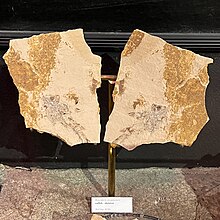 H. oregonensis, a related species H. oregonensis, a related species
|
| Genus
|
Species
|
Member
|
Abundance
|
Notes
|
Image
|
| Esox
|
E. kronneri
|
Fossil Lake
|
Only a single specimen known.
|
A pike.
|
|
| Genus
|
Species
|
Member
|
Abundance
|
Notes
|
Image
|
| Amphiplaga
|
A. brachyptera
|
Fossil Lake
|
|
A relative of trout-perch.
|

|
| Erismatopterus
|
E. levatus
|
Lake Gosiute, Lake Uinta
|
|
A relative of trout-perch.
|

|
| Genus
|
Species
|
Member
|
Abundance
|
Notes
|
Image
|
| Neanis
|
N. schucherti
|
Fossil Lake
|
|
A possible piciform of uncertain affinities.
|
|
| Pristineanis
|
P. kistneri
|
|
A possible piciform of uncertain affinities.[15]
|
|
| Genus
|
Species
|
Member
|
Abundance
|
Notes
|
Image
|
| Foro
|
F. panarium
|
Fossil Lake
|
|
A stem-turaco.[20]
|
|
| Genus
|
Species
|
Member
|
Abundance
|
Notes
|
Image
|
| Limnofregata
|
L. azygosternon
|
Fossil Lake
|
|
An early frigatebird.
|

|
| L. hasegawai
|
|

|
| Genus
|
Species
|
Member
|
Abundance
|
Notes
|
Image
|
| Vadaravis
|
V. brownae
|
Fossil Lake
|
|
Potentially a stem-ibis.[21]
|
|
| Genus
|
Species
|
Member
|
Abundance
|
Notes
|
Image
|
| Messelornis
|
M. nearctica
|
Fossil Lake
|
|
A messelornithid.
|
 Specimen of a related species Specimen of a related species
|
Neoaves incertae sedis
[edit]Two other genera, Eoeurypyga (a stem-sunbittern) and Wyomingcypselus (an early apodiform) are mentioned only in a 2002 dissertation[26], and are presently nomina nuda.
| Genus
|
Species
|
Member
|
Abundance
|
Notes
|
Image
|
| Apatemys
|
A. chardini
|
Fossil Lake
|
1 skeleton.
|
An apatemyid.
|

|
- ^ De Carvalho, Marcelo R.; Maisey, John G.; Grande, Lance (June 2004). "Freshwater Stingrays of the Green River Formation of Wyoming (Early Eocene), With the Description of a New Genus and Species and an Analysis of Its Phylogenetic Relationships (Chondrichthyes: Myliobatiformes)". Bulletin of the American Museum of Natural History. 284: 1–136. doi:10.1206/0003-0090(2004)284<0001:FSOTGR>2.0.CO;2. ISSN 0003-0090.
- ^ Grande, Lance (2001), Gunnell, Gregg F. (ed.), "An Updated Review of the Fish Faunas From the Green River Formation, the World's Most Productive Freshwater Lagerstätten", Eocene Biodiversity: Unusual Occurrences and Rarely Sampled Habitats, Topics in Geobiology, vol. 18, Boston, MA: Springer US, pp. 1–38, doi:10.1007/978-1-4615-1271-4_1, ISBN 978-1-4615-1271-4, retrieved 2024-08-17
- ^ Schwartz, Frank J. (2011-10-01). "An Emperical Synthetic Pattern Study of Gars (Lepisosteiformes) and Closely Related Species, Based Mostly on Skeletal Anatomy the Resurrection of Holostei". Journal of North Carolina Academy of Science. 127 (3): 219. doi:10.7572/2167-5880-127.3.219. ISSN 2167-5880.
- ^ a b c d e "Fossil Fish - Fossil Butte National Monument (U.S. National Park Service)". www.nps.gov. Retrieved 2024-08-17.
- ^ Grande, Lance (2001), Gunnell, Gregg F. (ed.), "An Updated Review of the Fish Faunas From the Green River Formation, the World's Most Productive Freshwater Lagerstätten", Eocene Biodiversity: Unusual Occurrences and Rarely Sampled Habitats, Topics in Geobiology, vol. 18, Boston, MA: Springer US, pp. 1–38, doi:10.1007/978-1-4615-1271-4_1, ISBN 978-1-4615-1271-4, retrieved 2024-02-25
- ^ Henrici, Amy C.; Báez, Ana M.; Grande, Lance (2013). "Aerugoamnis paulus , New Genus and New Species (Anura: Anomocoela): First Reported Anuran from the Early Eocene (Wasatchian) Fossil Butte Member of the Green River Formation, Wyoming". Annals of Carnegie Museum. 81 (4): 295–309. doi:10.2992/007.081.0402. ISSN 0097-4463.
- ^ Scarpetta, Simon G. (2024). "A Palaeogene stem crotaphytid ( Aciprion formosum ) and the phylogenetic affinities of early fossil pleurodontan iguanians". Royal Society Open Science. 11 (1). Bibcode:2024RSOS...1121139S. doi:10.1098/rsos.221139. ISSN 2054-5703. PMC 10776235. PMID 38204790.
- ^ "PBDB Taxon". paleobiodb.org. Retrieved 2024-08-17.
- ^ Carpenter, Kenneth (2018-10-18). "Soft-bodied fossil of a lizard from the Parachute Creek Member, Green River Formation (Eocene), Utah". Geology of the Intermountain West. 5: 263–269. doi:10.31711/giw.v5.pp263-269. ISSN 2380-7601.
- ^ Brochu, Christopher A. (2010-07-14). "A new alligatorid from the lower Eocene Green River Formation of Wyoming and the origin of caimans". Journal of Vertebrate Paleontology. 30 (4): 1109–1126. Bibcode:2010JVPal..30.1109B. doi:10.1080/02724634.2010.483569. ISSN 0272-4634.
- ^ Vlachos, Evangelos (2020-07-17). "The turtles from 'Gilmore's slab': evolution and diversity of the extinct turtle Echmatemys (Testudines: Testudinoidea: Geoemydidae) from the central United States". Journal of Systematic Palaeontology. 18 (14): 1193–1216. Bibcode:2020JSPal..18.1193V. doi:10.1080/14772019.2020.1754938. ISSN 1477-2019.
- ^ Musser, Grace; Clarke, Julia A. (2024-07-30). "A new Paleogene fossil and a new dataset for waterfowl (Aves: Anseriformes) clarify phylogeny, ecological evolution, and avian evolution at the K-Pg Boundary". PLOS ONE. 19 (7): e0278737. doi:10.1371/journal.pone.0278737. ISSN 1932-6203. PMC 11288464. PMID 39078833.
- ^ Weidig, Ilka (2006). "The first New World occurrence of the Eocene birdPlesiocathartes (Aves: ?Leptosomidae)". Paläontologische Zeitschrift. 80 (3): 230–237. Bibcode:2006PalZ...80..230W. doi:10.1007/BF02988439. ISSN 1236-9874.
- ^ Clarke, Julia A.; Ksepka, Daniel T.; Smith, N. Adam; Norell, Mark A. (2009-10-26). "Combined phylogenetic analysis of a new North American fossil species confirms widespread Eocene distribution for stem rollers (Aves, Coracii): NEW SPECIES FROM THE EOCENE GREEN RIVER FORMATION". Zoological Journal of the Linnean Society. 157 (3): 586–611. doi:10.1111/j.1096-3642.2009.00550.x.
- ^ Mayr, Gerald; Kitchener, Andrew C. (2024-06-01). "The Picocoraciades (hoopoes, rollers, woodpeckers, and allies) from the early Eocene London Clay of Walton-on-the-Naze". PalZ. 98 (2): 291–312. doi:10.1007/s12542-024-00687-9. ISSN 1867-6812.
- ^ Ksepka, Daniel T.; Clarke, Julia A.; Nesbitt, Sterling J.; Kulp, Felicia B.; Grande, Lance (2013-06-22). "Fossil evidence of wing shape in a stem relative of swifts and hummingbirds (Aves, Pan-Apodiformes)". Proceedings of the Royal Society B: Biological Sciences. 280 (1761): 20130580. doi:10.1098/rspb.2013.0580. ISSN 0962-8452. PMC 3652446. PMID 23760643.
- ^ Nesbitt, Sterling J.; Ksepka, Daniel T.; Clarke, Julia A. (2011-11-30). "Podargiform Affinities of the Enigmatic Fluvioviridavis platyrhamphus and the Early Diversification of Strisores ("Caprimulgiformes" + Apodiformes)". PLOS ONE. 6 (11): e26350. Bibcode:2011PLoSO...626350N. doi:10.1371/journal.pone.0026350. ISSN 1932-6203. PMC 3227577. PMID 22140427.
- ^ Mayr, Gerald; Kitchener, Andrew C. (2024-06-07). "The non-apodiform Strisores (potoos, nightjars and allied birds) from the early Eocene London Clay of Walton-on-the-Naze". Palaeobiodiversity and Palaeoenvironments. Bibcode:2024PdPe..tmp...21M. doi:10.1007/s12549-024-00610-9. ISSN 1867-1608.
{{cite journal}}: CS1 maint: bibcode (link)
- ^ Mayr, Gerald (2005). "The Palaeogene Old World potoo Paraprefica Mayr, 1999 (Aves, Nyctibiidae): Its osteology and affinities to the New World Preficinae Olson, 1987". Journal of Systematic Palaeontology. 3 (4): 359–370. Bibcode:2005JSPal...3..359M. doi:10.1017/S1477201905001653. ISSN 1477-2019.
- ^ Field, Daniel J.; Hsiang, Allison Y. (2018-06-25). "A North American stem turaco, and the complex biogeographic history of modern birds". BMC Evolutionary Biology. 18 (1): 102. Bibcode:2018BMCEE..18..102F. doi:10.1186/s12862-018-1212-3. ISSN 1471-2148. PMC 6016133. PMID 29936914.
- ^ Smith, Nathan D.; Grande, Lance; Clarke, Julia A. (2013). "A new species of Threskiornithidae-like bird (Aves, Ciconiiformes) from the Green River Formation (Eocene) of Wyoming". Journal of Vertebrate Paleontology. 33 (2): 363–381. Bibcode:2013JVPal..33..363S. doi:10.1080/02724634.2012.722898. ISSN 0272-4634.
- ^ Ksepka, Daniel T.; Grande, Lance; Mayr, Gerald (2019). "Oldest Finch-Beaked Birds Reveal Parallel Ecological Radiations in the Earliest Evolution of Passerines". Current Biology. 29 (4): 657–663.e1. doi:10.1016/j.cub.2018.12.040. ISSN 0960-9822.
- ^ Weidig, Ilka (2010-05-26). "New birds from the Lower Eocene Green River Formation, North America. In Proceedings of the VII International Meeting of the Society of Avian Paleontology and Evolution, ed. W.E. Boles and T.H. Worthy". Records of the Australian Museum. 62 (1): 29–44. doi:10.3853/j.0067-1975.62.2010.1544. ISSN 0067-1975.
- ^ Smith, N. Adam; DeBee, Aj M.; Clarke, Julia A. (2018-06-25). "Systematics and phylogeny of the Zygodactylidae (Aves, Neognathae) with description of a new species from the early Eocene of Wyoming, USA". PeerJ. 6: e4950. doi:10.7717/peerj.4950. ISSN 2167-8359. PMC 6022727. PMID 29967716.
- ^ Musser, Grace; Clarke, Julia A. (2020-10-26). "An Exceptionally Preserved Specimen From the Green River Formation Elucidates Complex Phenotypic Evolution in Gruiformes and Charadriiformes". Frontiers in Ecology and Evolution. 8. doi:10.3389/fevo.2020.559929. ISSN 2296-701X.
- ^ Weidig, Ilka (2003). Fossil birds from the lower eocene Green River formation (USA) (Thesis). Universitätsbibliothek Johann Christian Senckenberg.
- ^ Rietbergen, Tim B.; Ostende, Lars W. van den Hoek; Aase, Arvid; Jones, Matthew F.; Medeiros, Edward D.; Simmons, Nancy B. (2023-04-12). "The oldest known bat skeletons and their implications for Eocene chiropteran diversification". PLOS ONE. 18 (4): e0283505. Bibcode:2023PLoSO..1883505R. doi:10.1371/journal.pone.0283505. ISSN 1932-6203. PMC 10096270. PMID 37043445.














